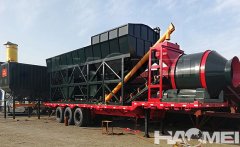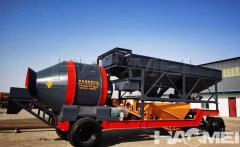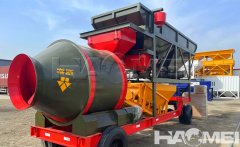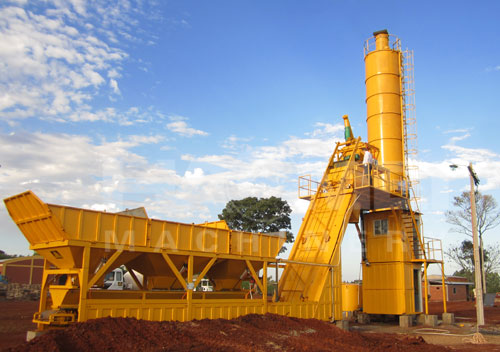Working Principle of Concrete Manufacturing Plant
Nov 25, 2025
A concrete manufacturing plant is a facility used to produce concrete, widely used in construction engineering, road construction, bridge construction, and other fields. Its main function is to mix raw materials such as cement, aggregates (sand, stone), water, and additives in a specific ratio to produce concrete that meets the requirements of the project. Concrete manufacturing plants can be divided into different types, such as stationary concrete batching plants and mobile concrete batching plants, suitable for engineering projects of different scales and types. With the development of technology, modern concrete batching plants are becoming increasingly intelligent, improving production efficiency and the quality stability of concrete.

Concrete manufacturing plants achieve efficient concrete production through the integration of automation technology, precise batching systems, high-efficiency mixing equipment, and scientific management processes. Its core working principle can be divided into the following key links, with each link working in tandem to ensure high efficiency.
1. Raw material storage and transportation:
- Aggregate storage:
Aggregates such as sand and stone are stored in closed silos according to particle size and automatically transported to metering hoppers via belt conveyors or pneumatic conveying systems, avoiding the inefficiency and errors of manual handling.
- Powder storage:
Cement, fly ash, and other powdery materials are stored in sealed silos and conveyed to the metering system via screw conveyors or pneumatic conveyors to prevent dust pollution.
- Liquid storage:
Water, admixtures, and other liquids are conveyed to metering tanks via pipelines. Some concrete mixing plants are equipped with heating/cooling systems to adapt to different temperature requirements.
- High efficiency:
Automated conveying systems reduce manual intervention, ensure continuous raw material supply, and avoid production interruptions due to material shortages.
2. Precise metering
- Metering equipment:
Electronic scales or sensors monitor the weight of aggregates, powders, water, and admixtures in real time, with errors controlled within ±1%, meeting the requirements for concrete strength stability.
- Dynamic adjustment:
Based on the concrete mix proportions (e.g., C30, C50, etc.), the system automatically adjusts the proportions of each raw material to ensure consistent quality in each batch of concrete.
- Error prevention mechanism:
Sensors detect whether raw materials are in place, preventing leakage or metering errors.
- High efficiency:
Precise metering reduces raw material waste and avoids concrete scrap due to incorrect proportions, improving production efficiency.
3. High efficiency mixing
- Mixing equipment:
Employs a JS twin-shaft forced concrete mixer, using blades to forcefully tumble and thoroughly mix raw materials. The mixing time is short (typically 60-90 seconds), significantly higher than that of gravity mixers.
- Mixing process:
Some batching plants utilize a "step-by-step feeding" technology, adding aggregates and a portion of water first, then adding powder and the remaining water. This reduces dust and improves mixing uniformity.
- Temperature control:
In winter, steam heating or hot water mixing is used; in summer, cold water circulation cooling ensures the concrete outlet temperature meets construction requirements.
- High efficiency:
The combination of short mixing cycles and high uniformity allows a single unit to produce hundreds of cubic meters per day, meeting the needs of large-scale construction projects.
4. Automated control and information management
- Central control system:
Integrated control of the entire process—raw material conveying, metering, mixing, and discharging—through PLC or industrial computers enables one-button start, automatic alarms, and fault diagnosis.
- Production scheduling:
Based on the client's order requirements, the system automatically schedules production and optimizes the production sequence, reducing equipment idle time.
- Data traceability:
Records production time, mix proportions, strength, and other data for each batch of concrete, facilitating quality traceability and process optimization.
- High efficiency:
Automation reduces human error, and information management enhances production scheduling flexibility, increasing equipment utilization by over 30%.
5. Environmental protection and energy saving design
- Dust control:
Fully enclosed design of silos, mixers, and conveyor belts, equipped with pulse dust collectors, achieving dust emission concentrations below 10mg/m³.
- Wastewater recycling:
Mixer cleaning wastewater is treated in sedimentation tanks and recycled, reducing water waste.
- Noise control:
Utilizes low-noise equipment and soundproof enclosures, achieving factory boundary noise levels below 60 decibels, meeting environmental standards.
- High efficiency:
Environmentally friendly design reduces the risk of downtime for rectification, while lowering energy costs (such as water and electricity consumption), improving overall efficiency.
6. Modular design and rapid installation
- Modular design: The main structure of the mixing plant (such as silos and mixing towers) uses standardized modules, allowing for rapid disassembly and assembly to adapt to different site conditions.
- Mobile concrete batching plants:
Some models are equipped with tire or tracked chassis, allowing them to be moved with construction sites and reducing relocation time.
- High efficiency:
Modular design shortens the installation cycle (typically 7-15 days). Mobile mixing plants meet the needs of temporary projects and improve equipment utilization.
The high efficiency of concrete manufacturing plants stems from a closed-loop system of "automated control + precise metering + efficient mixing + scientific management." By reducing manual intervention, optimizing the production process, and strengthening quality monitoring, the daily output of a single unit is maximized (e.g., the HZS180 concrete batching plant produces 1800 cubic meters of concrete per day), while simultaneously meeting environmental protection and energy-saving requirements, making it an indispensable "concrete factory" in modern construction projects.













 (Chat Online)
(Chat Online)




